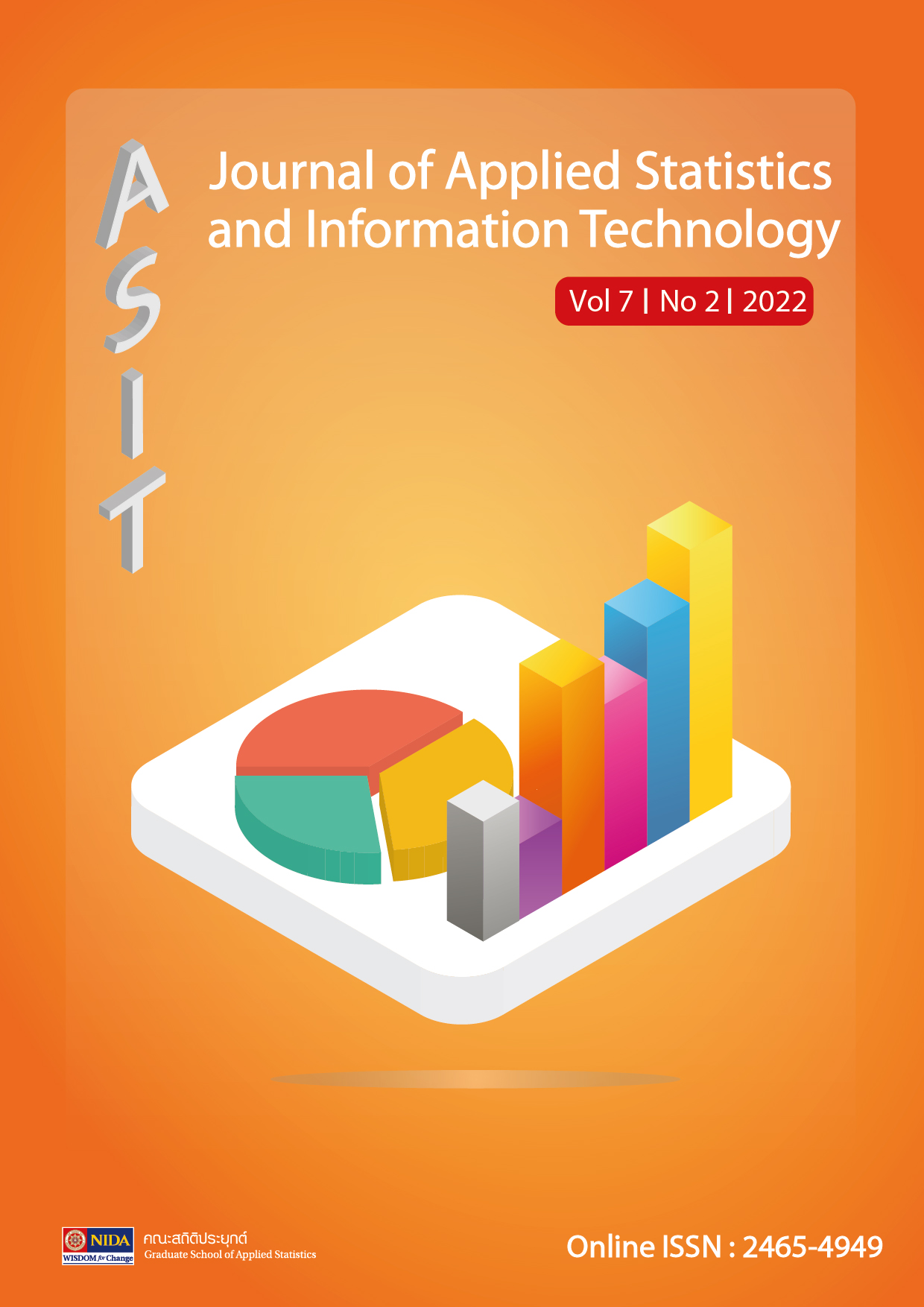Improving Efficiency of Warehouse Management using a Simulation Technique: A Case Study of Industrial Gas Distribution Company
Keywords:
Simulation, FSN Analysis, RetrievalAbstract
A case study of an industrial gas supplier company had a warehouse problem of inefficient item retrieval operations by human pickers, leading to spending too much time in the picking process resulting in costly delayed delivery. To formulate a more efficient way to manage such problems, the improving efficiency of the picking process in a warehouse was purposed by using a simulation technique. FSN analysis of inventory groups classified by consumption rate was constructed. Three groups of inventory items were identified i.e. fast-moving, slow-moving, and non-moving items. The analysis focused especially on the group of fast-moving items: industrial gas cylinder, welding wire, and cutting and grinding disc to redesign the warehouse storage layout by moving these items close to the packing station. Afterward, two scenarios using discrete order picking and batching picking methods were proposed and compared whether in which scenario could perform better in reducing the picking times and picking distances. The results of the simulation using ARENA software showed that the scenario of redesigning a storage layout combined with batching picking method outperformed the scenario of redesigning a storage layout combined with discrete order picking and the AS-IS model. It could reduce the picking time by 25.62%, the picking distance by 77.72%, and the total retrieval time by 19.06%. The research results could increase the efficiency of on-time delivery and reduce costs from delayed delivery of the case company.
References
คำนาย อภิปรัชญาสกุล. (2547). การจัดการคลังสินค้า. พิมพ์ครั้งที่ 1. กรุงเทพฯ : โฟกัสมีเดีย แอนด์ พับลีสซิ่ง.
เจนรตชา แสงจันทร์. (2562). การเพิ่มประสิทธิภาพการจัดการคลังสินค้าโดยประยุกต์ใช้วิธีการจัดแบ่งวัสดุตามความถี่ในการใช้ กรณีศึกษาบริษัทแห่งหนึ่งในอุตสาหกรรมการพิมพ์. การค้นคว้าอิสระหลักสูตรปริญญาบริหารธุรกิจมหาบัณฑิต สาขาวิชาการจัดการโลจิสติกส์ คณะบริหารธุรกิจ มหาวิทยาลัยราชมงคลธัญบุรี.
ชยุตม์ บรรเทิงจิตร. (2561). การประยุกต์ใช้เทคนิคการจำลองสถานการณ์ในการออกแบบผังคลังสินค้าเพื่อลดเวลาในการขนถ่ายวัสดุ. วิศวกรรมสารเกษมบัณฑิต. 8(3), 1-14.
ณัฐวดี ปัญญาพานิช และสมพงษ์ ศิริโสภณศิลป์. (2558). การประยุกต์ใช้แบบจำลองสถานการณ์ในการวิเคราะห์ประสิทธิภาพกระบวนการหยิบสินค้า. จุฬาลงกรณ์ธุรกิจปริทัศน์. 37(144), 24-50.
นภดล ร่มโพธิ์. (2554). การวัดความพึงพอใจลูกค้าและวัดความพึงพอใจพนักงาน. กรุงเทพฯ: มหาวิทยาลัยธรรมศาสตร์
รุ่งรัตน์ ภิสัชเพ็ญ. (2551). คู่มือการสร้างแบบจำลองด้วยโปรแกรม Arena. กรุงเทพฯ: ซีเอ็ดยูเคชั่น.
วรธน แสงศักดา. (2554). การจัดสรรพื้นที่การจัดวางสินค้าภายในคลังสินค้าโดยใช้แบบจำลองสถานการณ์ กรณีศึกษาอุตสาหกรรมอาหารกระป๋อง. วิทยานิพนธ์วิทยาศาสตรมหาบัณฑิต สาขาวิชาการจัดการโลจิสติกส์ บัณฑิตวิทยาลัย มหาวิทยาลัยเทคโนโลยีพระจอมเกล้าธนบุรี.
วลัยลักษณ์ อัตธีรวงศ์. (2561). การวางแผนการผลิต. กรุงเทพฯ : คณะวิทยาศาสตร์ สถาบันเทคโนโลยีพระจอมเกล้าเจ้าคุณทหารลาดกระบัง.
Bartholdi, J. J. and Hackman, S. T. (2014). Warehouse & Distribution Science. cited 11 September 2021 Retrieved from https://www. warehouse-science.com.
Charles, G. P. (2002). Considerations in Order Picking Zone Configuration. Journal of Operations and Production Management. 22(7), 793-805.
Dawis, R. V. (1994). The Minnesota Theory of Work Adjustment. Minneapolis: University of Minnesota Press.
Hmida, J. B., Parekh, S. and Lee, J. (2014). Integrated Inventory Ranking System for Oilfield Equipment Industry. Journal of Industrial Engineering and Management. 7(1), 115-136.
James, A. T. and Jerry, D. S. (1998). The Warehouse Management Handbook. (2nd Edition). Nottingham: Tompkins Press.
Kelton, W. D., Sadowski, R. P. and Zupick, N. B. (2015). Simulation with Arena. (6th Edition). New York: McGraw Hill.
Kumar, Y., Khaparde, R. K., Dewangan, K., Dewangan, G. K., Dhiwar, J. S. and Sahu, D. (2017). FSN Analysis for Inventory Management – Case Study of Sponge Iron Plant. International Journal for Research in Applied Science & Engineering Technology (IJRASET). 5(2), 53-57.
Melanie, C. (2018). FSN Analysis–How It Can Be a Useful Tool for Inventory Management. cited 9 August 2021 Retrieved from https://www.unleashedsoftware.com/blog/fsn-analysis-can-useful-tool-inventory-management.
Sooksaksun, N. and Sudsertsin, S. (2014). The Application of RFID in Warehouse Process: Case Study of Consumer Product Manufacturer in Thailand. LogForum Scientific Journal of Logistics. 10(4), 423-431.
Song, B. H., Lee, J. H., Jo, Y. D. and Park, K. D. (2016). Study on The Safety Management of Toxic Gas Cylinder Distribution Using RFID. International Journal of Safety and Security Engineering. 6(4), 209-218.
Wasusri, T. and Theerawongsathon, P. (2016). An Application of Discrete Event Simulation on Order Picking Strategies: A Case Study of Footwear Warehouses. European Council for Modelling and Simulation. 30(1), 121-127.
Wu, Y. J. and Chen, J. X. (2007). RFID Application in a CVS Distribution Center in Taiwan: A Simulation Study. International Journal of Manufacturing Technology and Management. 10(1), 121-135.
Downloads
Published
How to Cite
Issue
Section
License
Copyright (c) 2022 Journal of Applied Statistics and Information Technology

This work is licensed under a Creative Commons Attribution-NonCommercial-NoDerivatives 4.0 International License.
เนื้อหาและข้อมูลที่ปรากฏในบทความที่ตีพิมพ์ในวารสารสถิติประยุกต์และเทคโนโลยีสารสนเทศถือเป็นความคิดเห็นส่วนบุคคลของผู้เขียนแต่ละท่าน ความผิดพลาดของข้อความและผลที่อาจเกิดจากนำข้อความเหล่านั้นไปใช้ผู้เขียนบทความจะเป็นผู้รับผิดชอบแต่เพียงผู้เดียว บทความ ข้อมูล เนื้อหา รูปภาพ ฯลฯ ที่ได้รับการตีพิมพ์ในวารสารถือเป็นลิขสิทธิ์ของวารสาร หากบุคคลหรือหน่วยงานใดต้องการนำทั้งหมดหรือส่วนหนึ่งส่วนใดไปเผยแพร่ต่อหรือเพื่อกระทำการใดๆ จะต้องได้รับอนุญาตเป็นลายลักอักษรณ์จากวารสาร ก่อนเท่านั้น



